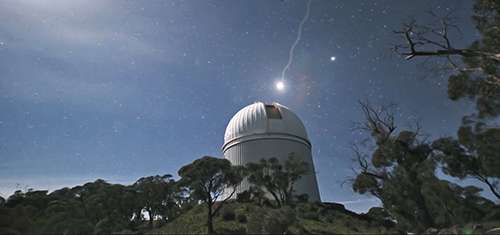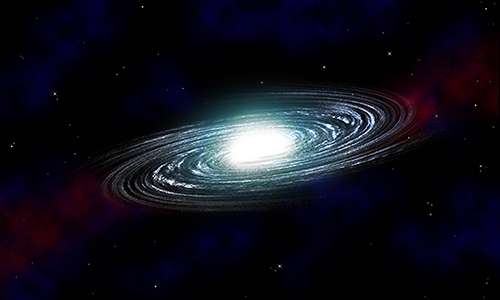An artist's impression of light from a distant star entering the Anglo-Australian telescope at Siding Spring Observatory to be analysed for the GALAH survey. Credit: Amanda Bauer, AAO
Archaeology is no longer earthbound but is being used to solve one of the fundamental mysteries of astronomy.
"We still don't understand how the more than 100 billion galaxies in our universe formed and evolved. Now we are going back to the very beginning of the Milky Way and using the astronomical equivalent of fossils to understand how our galaxy and those beyond it came about," said Dr Gayandhi De Silva, from the University of Sydney's School of Physics."Until now if we wanted to understand how the beautiful star clusters inside the Milky Way formed, or the spectacular spiral galaxies beyond it, we were limited to studying, at the very most, a few hundred stars from near the sun."
"By contrast GALAH probes ten times further into the galaxy and is the first attempt to survey a million stars to create a dataset that will be used by astronomers worldwide for decades to come."
The GALAH survey is an international five-year project, led by Australia, involving 70 astronomers from 17 institutions in eight countries.
It is led by Dr Gayandhi De Silva and Professor Joss Bland-Hawthorn from the University of Sydney and Professor Ken Freeman from the Australian National University. Dr De Silva is also the HERMES instrument scientist at the Australian Astronomical Observatory.
Illustration of a spiral galaxy on a star field background. The formation and evolution of spiral galaxies could be revealed by the GALAH survey
Dr De Silva is the lead author on Monthly Notices of the Royal Astronomical Society article, published today, outlining the background and goals of the survey.
GALAH refers to Galactic Archaeology with HERMES. HERMES is the new $13 million instrument on the Anglo-Australian Telescope at Siding Spring Observatory and can analyse light from up to 400 stars or galaxies at the same time. GALAH is the main purpose for which HERMES was built.
"Galactic archaeology means we 'dig down' into the chemical origin of stars to find out where they came from and how they formed," said Professor Bland-Hawthorn who, together with Professor Freeman, co-founded the discipline in 2002.
"Stars formed very early in our galaxy only have a small amount of heavy elements such as iron, titanium and nickel. Stars formed more recently have a greater proportion because they have recycled elements from other stars.
"We reach back to capture this chemical state - by analysing the mixture of gases from which the star formed. You could think of it as its chemical fingerprint - or a type of stellar DNA from which we can unravel the construction of the Milky Way and other galaxies."
The Milky Way is constantly in motion and stars that were born during its formation may have moved all the way to its other end, well away from their birth sites. Also not all the stars that call the Milky Way home were born there - they may have been forcibly merged into it from outside galaxies as the gravitational pull of the Milky Way cannabilises its satellites.
The scientists will use HERMES to measure up to 29 chemicals in the stars, as well as the stars' temperature, gravity and velocity to inform their understanding.
"Instead of only relying on what we can discover from their current positions GALAH allows us to trace the stars' origins - including the origin of our sun - and map their growth and movement through time and space," Dr De Silva said.
"Our archaeology of space is a new era in astronomy and the knowledge gained promises to be every bit as exciting and important as anything discovered on Earth."
More information: "The GALAH survey: scientific motivation." MNRAS (May 21, 2015) Vol. 449 2604-2617 DOI: 10.1093/mnras/stv327 First published online April 8, 2015
Journal information: Monthly Notices of the Royal Astronomical Society
Provided by University of Sydney

























